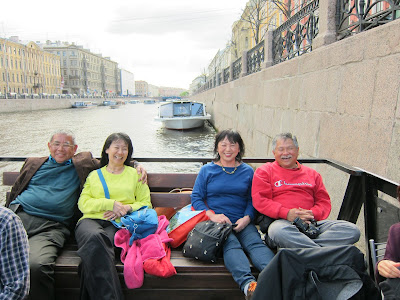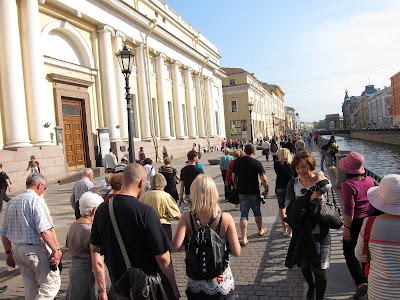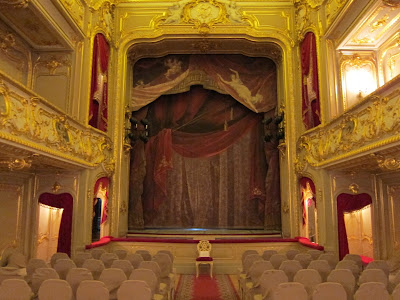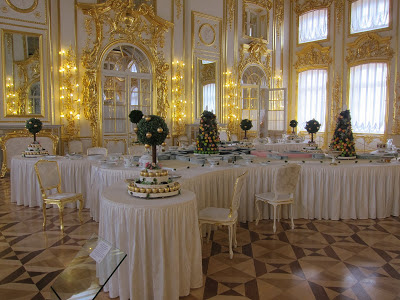The city underwent 3 changes of name. In 1914, its name was changed to Petrograd. In 1924, the communists renamed the city Leningrad to honour their leader Vladimir Lenin. After the fall of the Soviet Union, the people of the city decided through a referendum in 1991 to revert to its original name St Petersburg.
The city was the imperial capital of Russia until 1918 when the communists moved their government to Moscow. Because of its imperial past, the city is rich in tradition and culture. The old imperial presence and glory is still very much alive, evident in the many palaces, museums and cathedrals in the city.
It is also a city of water. Besides being a major sea port in the Baltic Sea, the Neva River and its many tributaries flow through it. There is also a network of canals. There are many cruises in these waterways and is a very interesting way to see city.
We cruised through the tributaries...
This beautiful building is the Church of the Saviour on Spilled Blood. The church was built in dedication to and in the very same spot where Tsar Alexander II was assassinated in 1881. Thus the bloody name. The architecture, with the domes and intricate design was typical of the many cathedrals that we would come across as we toured Russia. The interior artworks on the ceiling, walls and floors were no less amazing.
We had a very pleasant walk from the Church of Spilled Blood by a canal to a busy commercial area.
And we came another beautiful Cathedral of Our Lady of Kazan. Its architecture had a strong Roman influence and apparently was built to resemble the St Peter Basilica in the Vatican. We would had love to, but we could not get inside. It was closed.
From there we explored the city. We strolled along St Petersburg longest and busiest street - Nevsky Prospekt.
Then we went around looking for dinner. We found this terrible Italian/Japanese restaurant. This place served Italian and Japanese food. What a contrasting combination. How good could it get? But we had no choice. We were hungry and tired and didn't want to walk anymore.
I had this unagi don. It was rubbish. The eel was not fresh. The texture was soggy, almost like tofu. The serving was also very small. It might look like a big bowl. But it wasn't. The layer of rice below the eel was just about half inch thick.
This was an omelet don. I guess you can't go wrong with eggs. Like my unagi don, the serving was very small.
This was a dish of soba. A tiny portion in a massive bowl.
This was a chicken teriyaki don. The cucumber strips looked totally out of place. But Eddy seemed to enjoy it.
This was seafood fried udon. I guess this is the best looking of the meals we ordered.
Most ridiculous of all was this seafood soup soba. There was hardly 10 strands of the noodle in the bowl. Benson had a good laugh as he took the smallest dinner of his life.
We were of course not sated at the end of the Japanese fare. Plan B kicked in. Actually it was kind of good that they also serve Italian. These pizzas went well to fill our tummies.
Next day, we visited the Peter and Paul Fortress. It was a military bastion built by Peter the Great on an island in the Neva River. It was built in defence against a Swedish attack.
The fortress comprised several buildings including a prison block, mint, chapels, a museum...
And the majestic Peter and Paul Cathedral. This is the highest structure in St Petersburg.The cathedral was under extensive external restoration during our visit.
The interior of the chapel was spectacular, with golden altars...
Magnificent ceilings and chandeliers.
And the tombs of several Tsars, Tsarinas and other royal family members.
It was also the final resting place of Russia's last Tsar, Nicholas II and his family - Empress Alexandra, Princesses Olga, Tatiana, Maria, Anastasia and the Crown Prince Alexei. After the communists seized power in 1917, Tsar Nicholas and his family were banished to Siberia. There the whole family was assassinated and their bodies burnt and buried. In 1998 after DNA verifications, their remains were ceremoniously brought back to St Petersburg where they were finally laid to rest in a special room in the Peter and Paul Cathedral.
This is Russian ingenuity. Putting old buses to good use. Public toilets
Not far from St Isaac's Cathedral we found this small Russian restaurant. It was a cosy and comfortable place. We had lunch there.
I wanted some Russian food. So I ordered the beef stroganoff. It came in a creamy sauce and served with some salad. It was delicious.
My wife had this dish of chicken breast with mushroom served in a creamy sauce.
The pork chop looked rather dry. I don't think Benson enjoyed it very much. He looked at my beef stroganoff and I think he regretted ordering this.
Dessert was this crepe with a scoop of ice cream.
A nice cup of coffee completed a satisfying meal.
After lunch, we visited one of the largest and biggest art museum in the world - the Hermitage Museum. The museum was founded by Catherine the Great in 1764. It grew through the years and today it encompasses 6 buildings along the Neva River, including the former winter palace of the Russian Tsars.
Inside, it was long and elegant. The furnishings were more of a palace than a museum.
The museum boasts over 3 million works of art including the largest collecting of painting in the world. Only a fraction of it were on display.
They included works by painters like Leonardo da Vinci...
And Rembrandt.
Outside the Hermitage Museum is the huge Palace Square.
In the middle of the square stands the Alexander Column. It was constructed out of a single piece of red granite in 1830 to commemorate Russia's victory over Napoleon Bonaparte. The column stands on its own with no support and attachment to the ground.
The Yusupov Palace also known as Moika Palace, is located along the Moika River - a small tributary of the Neva. It was owned by a super rich noble family, the Yusupovs. This was also the place where Grigori Rasputin was murdered.
The Yusupovs were said to be as rich, perhaps even richer than the Tsar. They owned more than 50 palaces all over Russia. The extravagance of their lifestyle was reflected in the splendour of this palace. We could help but be awe stricken as we entered the palace. The lobby staircases with the chandeliers, wall carving, ceiling and other works of art were amazing.
We went through rooms after rooms of absolute luxury. There were the red rooms.
The blue rooms.
Th green rooms.
And many more. In their heyday, there were more than 40,000 works of art, including painting by Rembrandt. After the Soviet government took over the palace, these works of arts were transferred to the Hermitage Museum.
There was even a private theatre - still fully functional.
What was most interesting was the story of Rasputin. He was a monk in the days of the Russia's last Tsar Nicholas II. He became very close to Empress Alexandra because of his apparent power to relieve the bleedings and pains of Nicholas and Alexandra's only son, the haemophilic Crown Prince Alexei. Rumours abound that Rasputin and Alexandra were lovers.
Felix Yusupov was the last nobleman of the Yusupov family. He was unhappy about the relationship between Rasputin and the Empress, and plotted to murder him. He and his accomplices invited Rasputin to the Yusupov Palace where they served him food and wine laced with cyanide. Rasputin was unaffected after eating the poisoned meal. Felix and his co-conspirators then shot him several times at close range. Still he did not die. Desperate, they bludgeoned him with an iron rod, wrapped him in a blanket and dumped him into the freezing Moika River. Later, an autopsy found water in his lungs. He was still alive when he was thrown into the river. He apparently died of drowning or hypothermia in the icy water.
The above pictures were taken in the same rooms where Rasputin had the poisoned meal and where Felix and his accomplices conspired. The wax figures complete with replica of the poisoned meal were reconstruction of the incident in 1916. More real was this ghastly picture of the dead Rasputin.
We spent one morning in the Peterhof which is about 42 km from St Petersburg. Peterhof is a massive complex of luxury comprising several palaces and a huge garden. Its construction was started by Peter the Great in 1714 and over the years, it became the summer palace of the various Tsars. The biggest palace in Peterhof is the Grand Palace.
Peterhof is famed for the many fountains. There are more than 120 fountains in the compound, the biggest and grandest being the Grand Cascade, in front of the Grand Palace.
The fountains are beautifully adorned with many gold figurines and statutes.
All the fountains in the huge garden are synchronised to start at 11.00am each morning. At 11.00am sharp, music came through the sound system and all 120 over fountains started to spurt. It was a pretty sight.
This is one of the palaces in Peterhof.
Here are some shots of the beautiful garden complex.
We had lunch in a cafeteria in Peterhof. We wanted to try some Russian soups and these were what we got. I had this kharcho, a traditional Georgian soup of mutton ribs. It did not taste very nice. I was excited to find mutton soup in the menu. I was thinking in terms of our soup kambing. But it was no where near. I was rather disappointed.
"Home-made" noodle broth with meatballs. It apparently was also quite bland.
This was the chicken fricassee with mushroom and cream accompanied with spaghetti and cheese.
Eddy had this beef stroganoff. It was stewed with mushroom, tomato, paprika and sour cream, served with buckwheat. He didn't like it. I think the beef stroganoff I had 2 days earlier tasted better.
A spaghetti dish with chicken and mushroom in a creamy sauce.
Finally this was Chakhokhbili - a chicken stew with potato, tomato and onion. It was cooked with paprika and other herbs
After lunch, we proceed to the town of Tsarskoye Selo to visit Catherine Palace. Tsarskoye Selo is the town of Alexander Pushkin, the great Russian author and poet. This was where Catherine I built an imperial residence and that was also to become the summer palace of Russian Tsars.
The size of the palace was beyond belief. It was hard to imagine why anyone would need so much space to live it. Like other palaces we had visited or to visit, it told the story of the total lavishness and extravagance of the Russian royalty and nobility.
The palace was extensively damaged by the Nazis during the Second World War. It was painstaking restored and apparently restoration work on the interior of the palace chapel is still on-going.
The interior of the palace is one of golden opulence. There are about 380 rooms in the palace and almost every one is gilded with gold on the walls, ceilings, furnishings and architectural decorations. Apparently more than 100 kilograms of gold was brought from Siberia for this purpose. We could help but be dazzled.
The flooring was made with very fine parquet. We were made to wear shoe coverings to protect the wood.
I particular liked these blue fire places. They were in almost every room. They looked like the blue porcelains of the Chinese Ming Dynasty. I wondered if they are really porcelain.
While in St Petersburg, we took the opportunity to see some cultural shows. The ballet Swan Lake with music by Tchaikovsky was simply spectacular. This was my first time in a ballet and I enjoyed it. We were not allowed to use our camera during the performance. This picture of the stage is the best I can offer.
We also watched a Russian cultural show. The show was boisterous as Swan Lake was graceful. I think I liked Swan Lake better.
The food we ate in St Petersburg had been less than impressive. But there was one saving grace. And it was Chinese. Just outside our hotel was a restaurant that served some decent Chinese meals. Perhaps we were biased, but we visited the place at least 3 times.
It had a small inconspicuous entrance.
Inside it was quite big and comfortable.
I liked the Szechuan spicy sour soup. It was thick, spicy and had the oomph.
The kung po chicken was quite authentic, unlike that we had in Stockholm.
This was braised beef on a hot plate. Reminded me of the ones we had back home.
This one was interesting. Pork ribs served in a bamboo. I wondered why they bothered with the bamboo. Did absolutely nothing to enhance the flavour.
This was an egg plant dish. Delicious.
Braised mushroom. Not bad.
This was another interesting dish that I liked. Diced chicken stir fried with cucumber and cashew nuts.
Stir fried black fungus with celery. Simple yet good. I didn't know the two can be a combination.
The steamed fish in soy sauce was quite delicious. However I felt it was rather overdone. Oh yes, and expensive.
We spent 5 hectic days in St Petersburg. I wished we had more. We enjoyed the city. I particularly like the architecture, the culture and the grandiose of the places we visited. And the history. There was so much history in the short 310 years of its existence. St Petersburg had a lot more to offer. But we had to move on. And move on we did.












































































































No comments:
Post a Comment